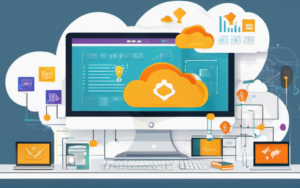The rise of cloud computing has been nothing short of revolutionary, transforming the way businesses store, manage, and access their data. This shift towards cloud-based solutions has sparked a debate about whether it will completely replace on-premises solutions. While cloud computing offers numerous advantages, the reality is more nuanced. Both cloud and on-premises solutions have their strengths and weaknesses, and the ideal approach often lies in a hybrid model that leverages the best of both worlds.
The Rise of Cloud Computing
Cloud computing refers to the delivery of on-demand computing services—including servers, storage, databases, networking, software, analytics, and intelligence—over the internet. Instead of investing in physical infrastructure, businesses can access these resources from cloud providers like Amazon Web Services (AWS), Microsoft Azure, and Google Cloud Platform.
Benefits of Cloud Computing
One of the key benefits of cloud computing is its scalability. Businesses can easily scale their resources up or down as needed, paying only for what they use. This flexibility is especially valuable for businesses experiencing rapid growth or fluctuations in demand. Cloud computing also offers increased accessibility, allowing employees to work from anywhere with an internet connection.
Types of Cloud Services
There are three main types of cloud services:
- Infrastructure as a Service (IaaS): This provides access to basic computing resources, such as servers, storage, and networking.
- Platform as a Service (PaaS): This offers a platform for developing and deploying applications, including tools for managing and deploying applications.
- Software as a Service (SaaS): This delivers fully functional software applications over the internet, such as email, CRM, and productivity suites.
On-Premises Solutions: Still Relevant?
While cloud computing has gained immense popularity, on-premises solutions continue to be relevant for certain businesses.
Advantages of On-Premises Solutions
On-premises solutions offer greater control over data and security. Businesses have complete ownership of their hardware and software, and they can implement customized security measures to protect sensitive information. They may also find on-premises solutions more suitable when dealing with highly regulated industries with strict data residency requirements.
Limitations of On-Premises Solutions
However, on-premises solutions come with their own set of limitations. They require significant upfront investment in hardware and software, which can be a major barrier for startups and smaller businesses. Managing and maintaining on-premises infrastructure also demands specialized IT expertise, which can be costly and time-consuming.
The Future of Cloud and On-Premises
Instead of seeing cloud and on-premises solutions as mutually exclusive, the future of IT infrastructure lies in a hybrid approach.
Hybrid Cloud Solutions
Hybrid cloud solutions combine the benefits of both cloud and on-premises environments. Businesses can choose to host certain applications and data in the cloud, while keeping others on-premises, depending on their specific needs and requirements. This approach allows for greater flexibility, cost-effectiveness, and scalability.
Coexistence and Collaboration
The future of IT infrastructure involves a seamless coexistence and collaboration between cloud and on-premises solutions. Cloud providers are actively developing tools and technologies that enable businesses to integrate their cloud services with their existing on-premises systems. This allows for a more unified and efficient IT ecosystem.
The Role of Edge Computing
Edge computing is another emerging trend that is expected to play a significant role in the future of IT infrastructure. Edge computing brings computing resources closer to the source of data, reducing latency and improving performance. It is often used in conjunction with cloud computing to provide a more robust and responsive IT infrastructure.
Choosing the Right Solution
The optimal approach to IT infrastructure will vary depending on the specific needs and circumstances of each business. Factors to consider include:
- Budget: Cloud computing can be more cost-effective in the long run, especially for businesses with fluctuating workloads, while on-premises solutions may be a better option for businesses with consistent workloads and a high tolerance for risk.
- Security: On-premises solutions offer greater control over data security, but cloud providers are constantly improving their security measures to address evolving threats.
- Compliance: Some industries have strict data residency requirements, making on-premises solutions a better choice. However, cloud providers are increasingly complying with these regulations.
Ultimately, the best approach is to choose the solution that best meets your specific needs and requirements. By carefully evaluating the benefits and limitations of both cloud and on-premises solutions, businesses can make informed decisions that will help them achieve their business goals.
The future of IT infrastructure is likely to be a mix of cloud and on-premises solutions, with businesses leveraging the advantages of both approaches to create a dynamic and flexible IT ecosystem. This will allow businesses to adapt to changing market conditions, respond to new opportunities, and achieve their business objectives.




